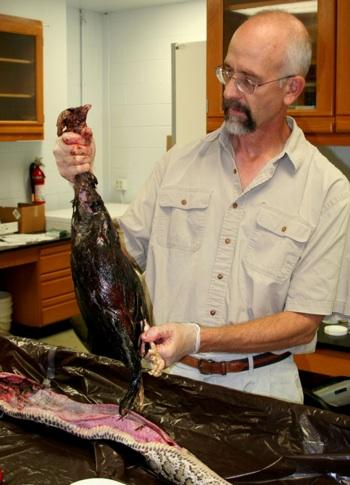You can add birds, and their eggs, to the prey that are falling victim to non-native Burmese pythons snaking through Everglades National Park, according to a study by Smithsonian Institution and National Park Service staff.
Necropsies performed on captured pythons provided evidence that the snakes have eaten at least 25 different species of birds found in the Everglades, according to a Smithsonian report.
"This finding is significant because it suggests that the Burmese python is not simply a sit-and-wait predator, but rather is opportunistic enough to find the nests of birds,” said Carla Dove, ornithologist at the Smithsonian’s Feather Identification Lab in the National Museum of Natural History and lead author of the study. “Although the sample size is small, these findings suggest that the snakes have the potential to negatively affect the breeding success of native birds.”
Earlier this year another team of scientists reported that the pythons were behind a "precipitous decline" in small mammal populations in the park.
The massive snakes, which have been known to kill even alligators in the Everglades, are behind a "nearly complete disappearance of raccoons, rabbits, and opossums" in the 1.5-million-park, according to the study published in the Proceedings of the National Academy of Sciences.
In the Smithsonian study, scientists reported that one 8-and-a-half-foot long python "regurgitated 10 whole guineafowl eggs soon after it was captured."
“Our observations confirm that invasive Burmese pythons consume not only adult birds but also eggs, revealing a previously unrecognized risk from this introduced predator to nesting birds,” said Ms. Dove. “How frequently they are predating on bird eggs is hard to know.”


 Support Essential Coverage of Essential Places
Support Essential Coverage of Essential Places







Comments
Despite having read a number of articles regarding concern over these snakes, I still don't know what -- if anything -- is being done to try to control them. It sounds as if some drastic eradication is needed. Are these things being hunted and killed or removed?
Roosters? Guineafowl? So are they attacking farm birds as well?
They must immediately allow unrestricted hunting and trapping of these snakes. I don't think there is any way now of eradicating them but it would reduce their population and save the lives of some native species. Is there some native American critter that likes to eat snakes? We don't need to import any more non-native animals, insects, plants or other that becomes another problem.
Chromedome
Funny that the two birds mentioned are themselves non-native to Florida??
Sounds like the makings of a jobs program to me: $25 per python.
Yah, bring in a Python to get your UI or Foodstamps. With 88 million citizens out of the workforce it shouldn't take long. Might help in getting more people to visit the Parks, also!
Currently, there are over 30 licensed Python Hunter & Trapper volunteers out searching and removing Burmese Pythons. There is no "bounty" for catching pythons, and pythons that were tested from the National Park had a high level of mercury which make them unsafe for human consumption.